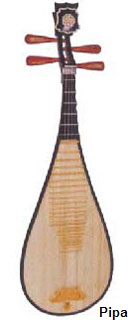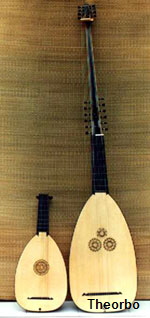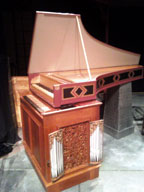|
"Do you speak Mandarin or mandolin?"
from Deborah Bogan's poem
After the State of the Union the Poem Goes Out for Coffee
What happens when an early music ensemble adds a cross-cultural element to their usual Renaissance music programming as the Folger Consort did for their opening 2009-2010 season?
THE CONSORT AND PENGYOU
On October 4, 2009 at the Folger Shakespeare Library in Washington, DC, this reviewer attended the Consort's program entitled "A Harmony of Friends: Music of Italy and China." The music selections included spiritual and secular Renaissance compositions by such Italian composers as Francesca Caccini (1587-1641), the first woman to compose an opera, and Claudio Monteverdi (1567-1643), the revolutionary composer who transitioned Renaissance music to the Baroque period. However, what made this Folger Consort program unique was the inclusion of Chinese traditional music set for the pipa,  a four-stringed lute favored by Chinese musicians and dating back in historical ledgers to the second century BC, as well as the use of the pipa in playing many of the Italian Renaissance compositions. a four-stringed lute favored by Chinese musicians and dating back in historical ledgers to the second century BC, as well as the use of the pipa in playing many of the Italian Renaissance compositions.
Joining Folger Consort founding musicians Robert Eisenstein (violin and viola da gamba) and Christopher Kendall (theorbo) were guest artists Risa Browder (violin), Jolle Greenleaf (soprano), Elizabeth Hungerford (soprano), Adam Pearl (harpsichord and organ), and Yang Wei (pipa). Yang Wei, who is associated as a pipa player with Yo Yo Ma's Silk Road Project, played four of the ten Italian Renaissance compositions presented in the first half of the "Harmony of Friends" concert and then, in the second half of the concert, he soloed three Chinese traditional compositions and was a player with the full complement of musicians and singers in two other pieces.
CLEARING AWAY THE DETRITUS OF NOISE
Early music, particularly those compositions written for spiritual use, has a way of cleansing the palate as well as clearing away the detritus of noise in the current day world. Eisenstein and Kendall employed interesting programming strategy by using the first half of their concert to show how collegial the pipa could be with early European instruments such as viola da gamba,  theorbo, and harpsichord in the playing of Italian Renaissance music. In the opening concert composition "Sinfonia" by Lorenzo Allegri (1567-1648), the pipa added a pizzicato that was delicate and upbeat but unlike any other sound being produced by the other instruments. theorbo, and harpsichord in the playing of Italian Renaissance music. In the opening concert composition "Sinfonia" by Lorenzo Allegri (1567-1648), the pipa added a pizzicato that was delicate and upbeat but unlike any other sound being produced by the other instruments.
THE LANGUAGE OF PIPA
The second half of the concert opened with these Chinese traditional compositions played solo on the pipa: "Moonlight Bathes a River on a Spring Evening," "The Ancient Battlefield," and "Spring in the Tian Mountains." Yang Wei delivered "Moonlight Bathes" both sensitively and intelligently, but this composition is what this reviewer expected Chinese music to sound like—somewhat tinny and lilting. However, "The Ancient Battlefield" electrified the small Shakespeare theater as Yang Wei presented the whole language of the battle with its shouting soldiers, neighing horses, fired weapons, and beaten drums. The overall effect of "Battlefield" was not unlike Flamencan guitar in its energy and requirements of the musician, except this piece vividly painted the story of battle. "Spring in the Tian Mountains," which started quietly, evolved into intricate fingering and strumming in the way this listener has experienced music of the Middle East, Balkan folk, or Spanish guitar.
Following the pipa solos of Chinese traditional music, the full cast of musicians and singers joined Yang Wei for a traditional song of the Yao Tribe. Yang Wei created the arrangement for this composition. The Consort players provided a rich brocade of sound with vocalizations from the two singers. The final work of the "Harmony of Friends" concert was excerpts from Monteverdi's "Scherzi Musicali." In this three-movement close, the pipa again played that pizzicato texture heard in the first composition of the program to complete a satisfying and full-circle appreciation of what the pipa added to this early music program.
This reviewer has heard pipa incorporated with Western music before. In fact, she heard Wu Man, another Silk Road Project pipa musician, play contemporary classical music with the Kronos Quartet, but until she experienced Yang Wei with the Folger Consort's "Harmony of Friends" concert, she had no real understanding of the pipa's virtuosity.
PAIRED INSTRUMENTS
While this review is focused on the Folger Consort's incorporation of the pipa with European period instruments, one should not overlook the accomplishments of the assembled musicians and singers and what each brought to this particular concert. For example most the musicians were playing multiple instruments including Adam Pearl who placed his harpsichord atop his organ. One particularly intriguing composition entitled "Surge propera" (Giovanni Paolo Cima) had singer Jolle Greenleaf stage center while hidden way Elizabeth Hungerford echoed what Greenleaf sang to surprising effect. Because their voices matched so well, one wondered whether Greenleaf was throwing her voice like a ventriloquist. For example most the musicians were playing multiple instruments including Adam Pearl who placed his harpsichord atop his organ. One particularly intriguing composition entitled "Surge propera" (Giovanni Paolo Cima) had singer Jolle Greenleaf stage center while hidden way Elizabeth Hungerford echoed what Greenleaf sang to surprising effect. Because their voices matched so well, one wondered whether Greenleaf was throwing her voice like a ventriloquist.
MONTEVERDI AND THE MAN WHO ENTERED THE FORBIDDEN CITY
How did this concert come about? Program notes from Robert Eisenstein explain that Monteverdi's Vespro della Beata Vergine nicknamed the 1610 Vespers, which will see its 400th anniversary next year and which the Folger Consort will play in January 2010 at Washington National Cathedral, is the focus of their 2009-2010 season. Additionally, the Folger Shakespeare Library is currently offering an exhibition called "Imagining China: The View from Europe 1550-1700." Most of the music selected for the "Harmony of Friends" concert was published around 1610. A key figure in the Folger exhibition is a Jesuit priest named Matteo Ricci (1552-1610), who was the first Westerner the Chinese allowed into Beijing's Forbidden City and who, being an occasional composer himself, probably brought some of Italy's contemporary music to the royal court of the Ming dynasty. Eisenstein conjectures that "surely Chinese musicians and the very musical Jesuit visitors would have wanted to compare notes, as it were, and invited each other to sample the wonderful musical styles of both cultures." Therefore, the Consort invited pipa player Yang Wei to help create and participate in the "Harmony of Friends" concert.
INVITING THE PIPA INTO THE CONSORT FAMILY
Has the Consort done other cross-cultural concerts? Yes, according to Eisenstein in a brief email interview, he answered this and other questions: "We have never worked with a pipa player before. We have, of course, done other multi-cultural concerts—notably with the Middle Eastern Ensemble's ouds, percussion, and Arabic flute in a program exploring the Conviviencia, the confluence of Christian, Jewish, and Islamic culture in medieval Spain."
When asked what other connections besides the Folger Library's European-Chinese exhibition did he envision the audience leaving the concert with, Eisenstein answered, "Well, the relationships among Asian and European instruments are very interesting. Both the Chinese erhu and the European viola da gamba, for instance, are bowed with the underhand technique, which seems to have spread east and west from the Mongolian morin khuur. The pipa and the lute are obviously related. And then Chinese traditional music, mainly from an oral tradition, reminds us very much of medieval European things like troubadour songs and 13th century dances...."
Eisenstein was very enthusiastic about the blending of pipa with European period instruments and commented, "I loved it! Yang Wei is such a great and flexible artist, and it was a complete pleasure to experiment. He picked up early Baroque style very rapidly, and I think in terms of sound the instrument blends really well with viols, violins, harpsichord, and lutes." Eisenstein is thinking also about inviting Yang Wei back for programming involving medieval and 18th century music.
CROSS-CULTURAL, CROSS CENTURIES
That Eisenstein's founding partner Christopher Kendall is the artistic director of the 21st Century Consort at the Smithsonian Institution did not escape this reviewer's attention. So the question that hangs in the air is by adding the pipa to the playing of early European music has the Folger Consort created new classical music?
Photograph of two theorbos courtesy of David Van Edwards
|

